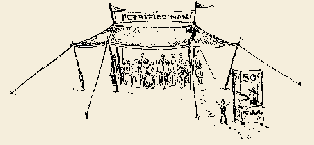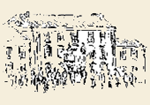|
The Cardiff Giant
Lives on in Legend

by
One of the biggest hoaxes ever perpetrated on the general public was
conceived by a group of people, one of whom was David Hannum, known more
commonly as David Harum of Homer fame.
Although its creators are long deceased, the legacy of the "petrified
man," known as the Cardiff Giant, lives on, and is a center of attraction
at the Farmers' Museum in Cooperstown.
On October 16, 1869, workmen unearthed a 10½-foot tall stone giant on
the farm of Stub Newell in Cardiff, a rural area in southern Onondaga
County not far from LaFayette. This spot, coincidentally, was the site
of the famous 1993 mudslide that destroyed several homes.
The find created a sensation so great that it even caught the attention
of the renowned P. T. Barnum. He attempted, unsuccessfully, to purchase
the Cardiff Giant and capitalize on the find. The male figure was carved
from gypsum and was the subject of a facetiously written booklet entitled
"Autobiography of the Great Curiosity the Cardiff Giant."
The story of the Cardiff Giant is an example of how the general public
can be duped into believing anything by a convincing argument, at which
Barnum was a master. It is said he coined the phrase, "There's a sucker
born every minute."
The idea of the Cardiff Giant originated with George Hull, a Binghamton
businessman. He was visiting relatives in Iowa, and one night, while reading
the Bible, he thought to himself, if people believed everything they read
there about giants roaming the earth, he would produce one and pass it
off as a petrified man, and get rich.
After an extensive search, he found a suitable outcropping of gypsum,
gray in color, with dark-colored bluish streaks, which he afterward passed
off as veins of a human body. Hull hired a gang of men to cut out a block
of gypsum 11 feet, 4 inches long, 3 feet, 6 inches wide, and more than
two feet thick.
The block was then transported by wagon 45 miles to the nearest railroad
station at Boone, Iowa, where it was loaded into a boxcar and shipped
to Chicago. There, Hull rented a building and had a stone cutter shape
the block into a man's image.
To give it some authenticity, Hull made a tool resembling a hair brush,
into which he inserted darning needles. He then ran it over the statue,
pitting it with thousands of little holes to resemble skin pores. Hull
then swabbed the body with sulfuric acid which gave the stone a dingy
brown color. He recalled, "Then I put the giant in an iron-bound box and
shipped it by rail to Union, nine miles from Binghamton." Packaged it
weighed 4,000 pounds.
Because many petrified fish and reptiles had been discovered there over
the years, Hull said he decided to have the giant buried on a farm near
Cardiff. The area was once covered by a lake in prehistoric times. Hull
was related to Stub Newell.
In the dead of night the giant was unloaded from a boxcar at Tully, and
taken by wagon to the Newell farm. At midnight, in the pouring rain, it
was placed in the back of Newell's barn and covered with hay and straw.
A few nights later, it was buried in a "grave" nearby. "Indeed it was
no small job to remove all trace of the midnight burial," Hull said.
On Saturday, October 16, 1869, according to a pre-conceived plan, Newell
hired some men to dig a well behind the barn-—coincidentally where
the giant lay buried. One can only imagine the expression on their faces
when they unearthed the giant. What followed was a scenario that developed
into one of the greatest hoaxes of the 19th century.
Newell set up a tent and charged 50 cents admission. It is said he made
more money in a month than he did all year long farming on a rocky hillside—even
after splitting the proceeds with Hull, Hannum and other investors who
had purchased shares in the fraud.
Triple rows of spectators surrounded the excavation for days. Even the
state geologist and a party of scientists certified, after careful examination,
that the petrified man was authentic.
It took a young paleontologist from Yale University, O. C. Marsh, to
expose the fraud. When he revealed that the giant was nothing more than
a piece of gypsum, the hoax unraveled into a scandal.
Thus, from a household word of being the greatest scientific discovery
of the 19th century, the Cardiff Giant fell to the level of a sideshow
curiosity. But the Giant continued to be a good investment as it was exhibited
all over the country.
Over the years, the Giant passed through several owners, including a
syndicate known as the Cardiff Giant Association. It eventually made its
way back to Iowa, where it became a curiosity in a rumpus room. In the
1940s it was brought to the attention of the New York State Historical
Association and was brought back east to become an exhibit at the Farmers'
Museum, where it continues to draw the attention of visitors.
An anecdote is told of David Hannum's connection with the Giant. One
day in the 1870s he boarded a train in Homer bound for Syracuse and was
seated when approached by a dapper looking young man named P. Elmendorf
Sloan, who at the time, was superintendent of the Syracuse & Binghamton
Railroad. Hannum was a large man and took up most of two seats. Sloan
asked him to move over, but Hannum refused.
"See here," Sloan said, "do you know who I am? My name is Sloan and my
father, Sam Sloan, is president of this railroad."
"See here," Hannum retorted, "do you know who I am? My name is David
Hannum and I'm the father of the Cardiff Giant."
| 


